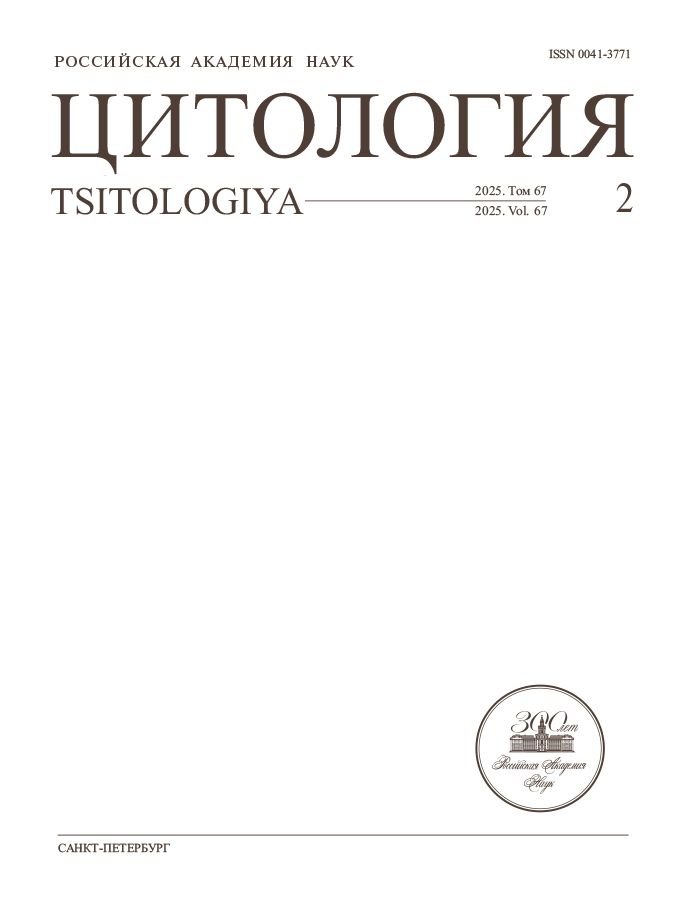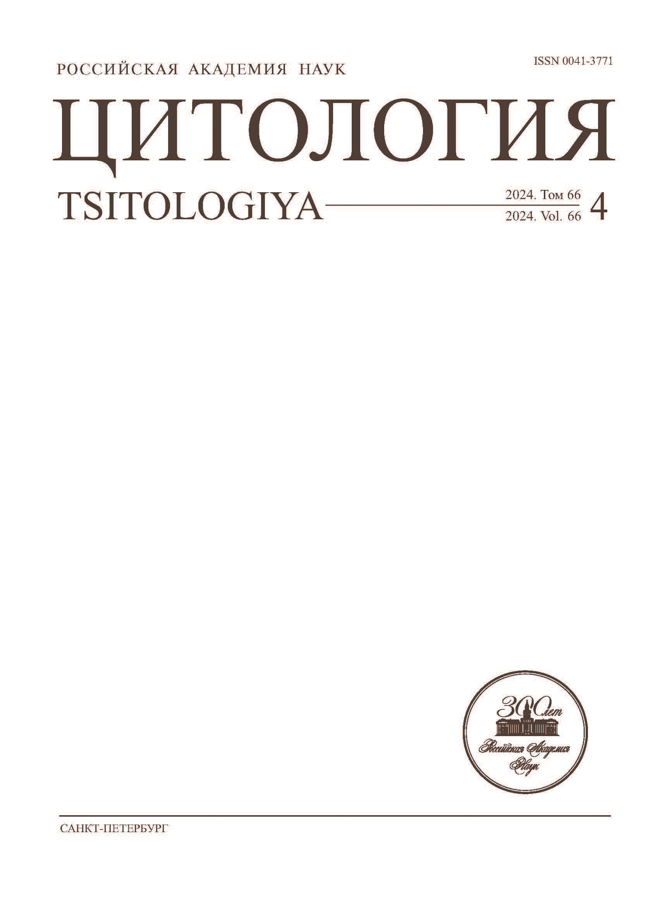Vol 66, No 4 (2024)
Articles
Functions of microcephalin in neurogenesis and human brain evolution
Abstract
Primary microcephaly is a brain growth disorder of which the main phenotypic hallmarks is a reduction of brain size with varying degrees of intellectual disability. MCPH1 is the first gene reported to cause primary microcephaly. Microcephalin (MCPH1), the encoded protein product, has been implicated in various cellular processes deregulation of which can negatively affects neurogenesis. In our review we will discuss the clinical cases of MCPH1 primary microcephaly and summarize the knowledge about the functions of MCPH1 employing animal models with mutations in various domains of MCPH1. We also pay special attention to the role of MCPH1 in in the evolution of the human brain.
 309-329
309-329


Melanoma cells adhesive properties activation in 3d spheroids
Abstract
In this study, the viability and adhesive features of BRO and SK-MEL-2 cell lines were evaluated using a melanoma model. It was revealed that in BRO cells, the development of apoptosis after exposure to dacarbazine was combined with the transition of the proportion of cells to the G0 phase of the cell cycle, that corresponded to previously obtained results. The absence of apoptosis in 3D spheroids and the absence of exit from the cell cycle were observed in SK-MEL-2 melanoma cells. It was also revealed that in the control spheroids (cells without exposure) of the BRO and SK-MEL-2 melanoma lines, adhesion to fibronectin was higher compared with the cells of the control monolayer, which is explained by the three-dimensional structure requiring cell communication with the extracellular matrix. In spheroids formed by SK-MEL-2 cells, dacarbazine induced a decrease in adhesion to fibronectin, which may be associated with the development of drug resistance. An increase in the expression of integrins AV and β8 in BRO and SK-MEL-2, as well as integrin β5 in SK-MEL-2, was determined in cells after exposure to dacarbazine, which may indicate the involvement of aforementioned molecules in the exit from proliferative stage of tumor cells.
 330-340
330-340


New line of mesenchymal stem cell isolated from warton’s jelly of the umbical cord of male human donor
Abstract
A new non-immortalized fibroblast-like cell line, named MSCWJ-3, was generated and characterized. Characteristics during long-term cultivation (6–24 passages) confirm the status of MSCs. It is shown: 1) a gradual increase in the proportion of senescent cells during long-term cultivation; 2) a significant decrease in the proliferation index by the 24th passage; 3) preservation of the normal diploid karyotype of the man (46, XY) during the entire period of cultivation, trisomy for different autosomes in single cells, absence of structural chromosomal rearrangements; 4) a high proportion of cells carrying surface antigens characteristic of MSCs: CD44, CD73, CD90, CD105, HLA-ABC and a low proportion with antigens CD34, CD45 and HLA-DR over 24 passages. Cells of the MSCWJ-3 line are capable of differentiation in the osteogenic and adipogenic directions at early and late passages; differentiation in the chondrogenic direction is absent. In general, there are some differences with previously obtained lines isolated from the same source and are associated mainly with the degree of expression of a number of status characteristics.
 341-354
341-354


The culture of equine adipose tissue-derived mesenchymal cells in serum-free media
Abstract
Mesenchymal stem/stromal cells (MSCs) isolated from equine adipose tissue (AT) represent a promising material for the creation of bioveterinary products for the prevention and treatment of many diseases. The production of these cells for clinical use requires improved serum-free culture conditions. The microenvironment can influence the properties of MSCs. It is believed that the requirements for culture conditions without animal blood serum are species specific. The purpose of this study was to evaluate the commercially available serum-free media (SFM) MesenCult (STEMCELL Technologies, USA), created for human MSCs, for the cultivation of equine MSC(AT). One part of the cells was propagated for 10 passages in the standard DMEM medium with a low glucose content (1 g/l) and 10% fetal bovine serum (FBS), and the second in SFM. The results show that the propagation of equine MSCs in MesenCult serum free, intended for the cultivation of human MSCs, is possible, since the cells adapt well to it and retain properties characteristic of cells that are cultured in DMEM with FBS: morphology, growth rate, doubling time and mitotic index, clone-forming abilities, diploid set of chromosomes, a large number of cells with the CD90 phenotype (90.8%) and low with the CD31 (0.8%), CD34 (0.9%) phenotype, as well as the potency for induction of differentiation into adipo-, osteo- and chondrogenic directions. Equine MSC(AT) showed stable characteristics after being cultured for 10 passages in SFM, providing a promising basis for their further use. Our results demonstrate that MesenCult media may be an alternative for serum-free culture of equine MSC(AT) for expansion in preclinical studies.
 355-366
355-366


Effect of nanocluster polyoxometalate {mo72fe30} on morphofunctional state of macrophages in cultures
Abstract
The aim of this work was to study the effect of nanocluster polyoxometalate {Mo72Fe30} on the macrophage link of the immune system. In vitro studies of polyoxometalate on macrophage cultures allowed us to evaluate the reaction of immune system cells (in particular, peritonial and alveolar macrophages) to nanoparticles. The analysis of the obtained data allowed to establish that {Mo72Fe30} is not toxic for peritonial and alveolar macrophages, has no significant effect on the morphology of cells, as well as on the activity of α-naphthylacetate esterase. However, it significantly reduces phagocytic activity when cells are cultured with POM, which may indicate possible polarisation of macrophages. The obtained results confirm the possibility of using {Mo72Fe30} in the field of biomedicine.
 367-379
367-379


Development of an in vitro model of dysferlinopathy via crispr/cas-mediated transcriptional activation of the dysf gene
Abstract
Scientists need cell models from human tissues to develop methods of gene therapy and genome editing for monogenic diseases. It is preferable to use minimally invasive methods to obtain samples; these tissues can be applied for further screening in order to select the most effective approach to restore the synthesis of the target protein. We used the CRISPR/Cas9-SAM transcriptional activation system, which ensures expression of the DYSF gene in HEK293Т cells, as well as in fibroblasts from patients with dysferlinopathy (c.2779delG (Ala927LeufsX21)). After targeted activation of DYSF, it was possible to detect the main gene products: mRNA and protein (HEK293Т_ТА) and mRNA (fibroblasts). Transcriptionally activated dysferlin-deficient fibroblasts and HEK293 cells can be used to evaluate the in vitro efficacy of gene therapy for dysferlinopathies.
 380-392
380-392













